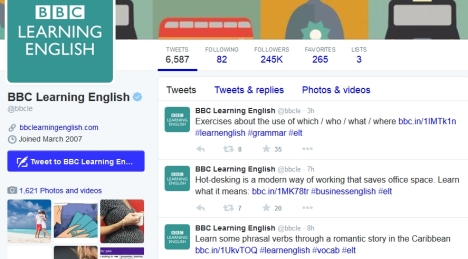Why Computer Science Education in K-12 Settings Is Becoming Increasingly Essential by Mehran Sahami, The Huffington Post, 14 Sep. 2016.
Is computer science for everybody? In this blog post, the author reminds us that in today’s world, computer science goes beyond programming for programmers. It is more and more part of our everyday lives. The author asserts, “This is the reason we don’t talk about teaching CS as just teaching ‘programming,’ but rather as a means for students to develop ‘computational thinking’ skills.”
Ex-Google Guy Builds English Teaching App That Adapts to Student by Selina Wang, Bloomberg Technology, 13 Sep. 2016.
Chinese parents spend quite a bit of money for English lessons for their children, then find out that their children don’t speak English very well. In steps LiuLiShuo, which means “speaking fluently,” an app which incorporates gaming and social media into English learning. While it has its critics, it also has 30 million (yes, million) users.
Audiobooks Can Support K-12 Readers in the Classroom by Kate Stoltzfus, Education Week, 19 Sep. 2016.
Audiobooks have been around for quite a while, and their usefulness for struggling readers has been supported by research. With the growth of digital media, audiobooks are becoming even more important as a tool for learners, especially students who have trouble reading. A study by the American Association of Schools Libraries in 2012, which focused on elementary students, found that “audiobooks improved students’ reading scores, increased students’ positive attitudes about their reading ability, and offered students more personal choice in what they read.”
Filed under: Apps, Ed Tech, ESOL, International, K-12 Schools, Language Learning, Library, Literacy, Social Media, Trends & Issues | 1 Comment »
























 John Mark Walker: "If educational communities can continue to push platform integration and content portability, in the future, students may be able to design their own personalized degrees from smaller, modular chunks that cross institutional barriers" (
John Mark Walker: "If educational communities can continue to push platform integration and content portability, in the future, students may be able to design their own personalized degrees from smaller, modular chunks that cross institutional barriers" ( Richard Koubek
Richard Koubek
 Judith McDaniel
Judith McDaniel Tim Fraser-Bumatay: "Although the format leaves us far-removed physically, the online forum has its own sense of intimacy" (Judith McDaniel, "
Tim Fraser-Bumatay: "Although the format leaves us far-removed physically, the online forum has its own sense of intimacy" (Judith McDaniel, " Ryan Kelly: "For me to be able to work with people clear across the country for an extended period of time opened me up to new things" (Judith McDaniel, "
Ryan Kelly: "For me to be able to work with people clear across the country for an extended period of time opened me up to new things" (Judith McDaniel, " Daniel Herrera: "As a Mexican American, I know that words of identity are powerful; so to discuss white privilege with my professor and classmates in a face-to-face class would have been terrifying and impossible" (Judith McDaniel, "
Daniel Herrera: "As a Mexican American, I know that words of identity are powerful; so to discuss white privilege with my professor and classmates in a face-to-face class would have been terrifying and impossible" (Judith McDaniel, "












 Cathy Gunn: "Traditional methods for effecting change at my institution aren’t getting us even to a trickle yet, let alone to thinking about or planning for a wave!" (
Cathy Gunn: "Traditional methods for effecting change at my institution aren’t getting us even to a trickle yet, let alone to thinking about or planning for a wave!" (









